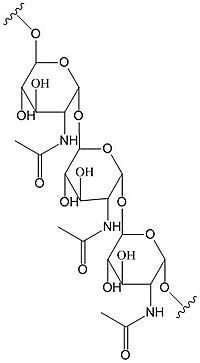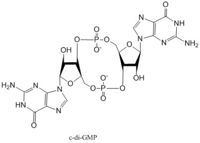From Proteopedia
proteopedia linkproteopedia link
| This Sandbox is Reserved from 02/09/2015, through 05/31/2016 for use in the course "CH462: Biochemistry 2" taught by Geoffrey C. Hoops at the Butler University. This reservation includes Sandbox Reserved 1051 through Sandbox Reserved 1080.
|
To get started:
- Click the edit this page tab at the top. Save the page after each step, then edit it again.
- Click the 3D button (when editing, above the wikitext box) to insert Jmol.
- show the Scene authoring tools, create a molecular scene, and save it. Copy the green link into the page.
- Add a description of your scene. Use the buttons above the wikitext box for bold, italics, links, headlines, etc.
More help: Help:Editing
|
DgcZ from E. coli
Diguanylate cyclases synthesize cyclic dimeric-GMP (c-di-GMP) from two GTP molecules.
C-di-GMP is a second messenger in the production of poly-β-1,6-N-acetylglucosamine (poly-GlcNAc)

poly-β-1,6-N-acetylglucosamine
, a polysaccharide required for
E. coli biofilm production. This biofilm allows
E. coli to adhere to extracellular surfaces. The DgcZ protein is made of two domains: the catalytic GGDEF domain responsible for sythnesizing c-di-GMP and the regulatory CZB domain that binds zinc. When zinc is bound, the CZB and GGDEF domains adopt conformations that inhibit DgcZ function. DgcZ binds zinc with sub-femtomolar affinity, making it very likely that zinc will bind in the CZB domain.
Structure
Catalytic GGDEF Domain
E. coli DgcZ is a protein made of two domains each of which is a symmetric homodimer. The GGDEF domain is made of a central five-stranded β-sheet with five α-helices surrounding it. Each dimer contains an active half-site that, when combined together in a productive conformation, form the entire active site. Each half-site binds one GTP. The guanyl base forms hydrogen bonds with asparagine-173 and aspartate-182 to hold it in the active site. A magnesium2+ ion stabilizes the negative charges on the phosphate groups. When in the productive conformation, each GTP is held in close proximity with the α-phosphate groups overlapping C3 of the ribose. This conformation allows the α-phospate of one GTP to react with alcohol on C3 on the ribose of the other GTP, resulting in a cyclization of the two molecules into cyclic-dimeric-GMP.
CZB Domain
Mechanism of Action
Zinc Ligand(s)
Inhibition
Other Ligands
References


